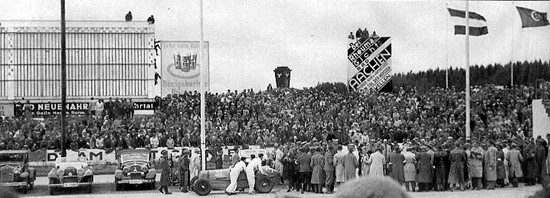|
An incident in Germany
DODGING THE CURRENCY LAWS

The Nurburgring stadium during the 1935 meeting
MOST PEOPLE would imagine Raymond
Mays to be an honest citizen and no doubt he was a dedicated observer of
the law, except perhaps when it came to motoring, having been prosecuted
for speeding on at least one occasion, but then few drivers even today
recognise this infringement as little more than an acceptable
misdemeanour.
International currency crime therefore comes as a surprise but that is
what he committed in the years before the Second World War after attending
a race meeting in Germany. Raymond and his team went there in June 1935 to
participate in the Eifel Rennen on the Nurburgring circuit, taking with
them three 1½ litre works models of the new ERA car, the first serious
competitive event abroad, with director designer Peter Berthon and a full
team of mechanics and support staff.

The ERA fleet of lorries
He knew the reputation of the circuit as the most difficult course in the
world, some 14 miles in length with only one straight. The event was also
held during the rise of Nazi supremacy and on the day of the race,
attended by 400,000 spectators, the scene of the start was most
impressive. “Storm troopers of the SS lined the course by the start, bands
were playing and the enormous crowd had to be seen to be believed”, said
Raymond afterwards.
| “The flags of the contending nations
were fluttering in the breeze by the enormous scoreboard and the old Nurburg Castle
towered majestically in the background. ”Seventeen cars from all nations started
and Raymond won with a time of 1 hour
38 minutes 33 seconds, an average speed
of 69.03 mph and breaking the lap record
in the process.
“Crowds surged around the car”, he said. “Press
cameras seemed to be clicking everywhere and all the ERA personnel
were frenzied with delight at our victory. I was almost hoisted from
my car by German storm troopers and escorted to a special
grandstand. There our national anthem was played and a high ranking
Nazi official placed a laurel wreath around my neck and the car
was garlanded around the bonnet.” |
 |
All of the ERAs had finished in the first four places and the following
day, Raymond and his team paid a visit to the race office to collect their
starting money of £150 for each car plus the prize money, the equivalent
of several hundreds of pounds, but were surprised to find that it was
subject to Germany's restrictive currency regulations. “This money meant a great deal to us
because apart from the prestige of our victory, the cash would help to
continue to improve the cars and carry out more experimental work”, he
said. “But when we were told that our prize money should be spent in
Germany and not taken back to England, we were not so thrilled. Arguments
took place and finally we collected the money.”
Raymond and his team were still determined to keep the cash and that
night, as the team helped load the four ERA cars and spares into the vans
for the road journey home, they decided to smuggle the hundreds of mark
notes back to England, knowing that it would be a risk as they were
breaking the law and running a real chance of detection because a very
thorough search would be made of all vehicles at the German frontier.
He later described what happened next: “Behind locked doors, by the dim
light of a torch, Peter and the mechanics rolled the notes into round
bundles and, with the aid of a long thin stick, pushed the bundles up the
exhaust pipes and actually into the exhaust manifolds of all three cars.
On arrival at the frontier next day, our hearts missed a beat as the
customs officials carried out a most thorough search, including asking for
the sparking plugs to be removed, but they found nothing and we reached
England with our winnings intact.”
Back in Bourne, the marks were exchanged for pounds sterling and so
enabled ERA continue in business while the celebration ribbons from the winner’s wreath
presented to Raymond were also brought back and kept as mementos of a
successful trip.
|
THE WINNER'S RIBBONS |
|
 |
The ribbons from
the winner's wreath at Nurburgring in 1935 are preserved in the
Raymond Mays Memorial Room at the Heritage Centre in Bourne. |
 |
NOTE: Acknowledgments to Split Seconds -
My Racing Years
by Raymond Mays (G T Foulis & Co Ltd, London, 1950).
Return to
Raymond Mays

Go to:
Main Index Villages
Index
|




